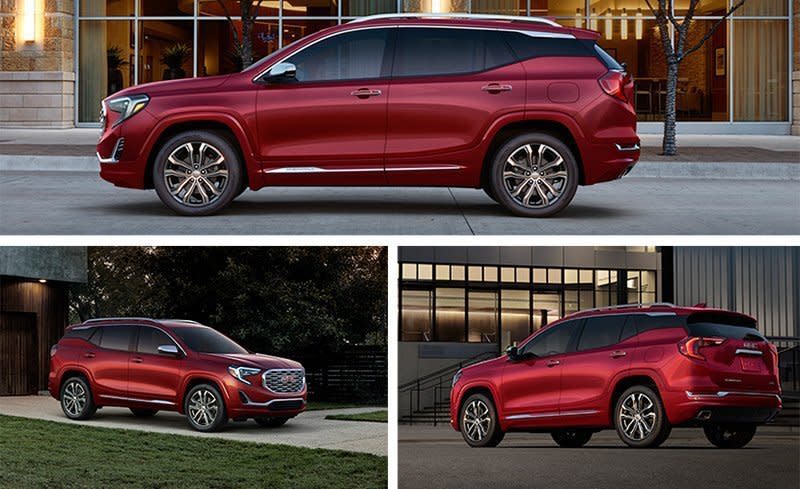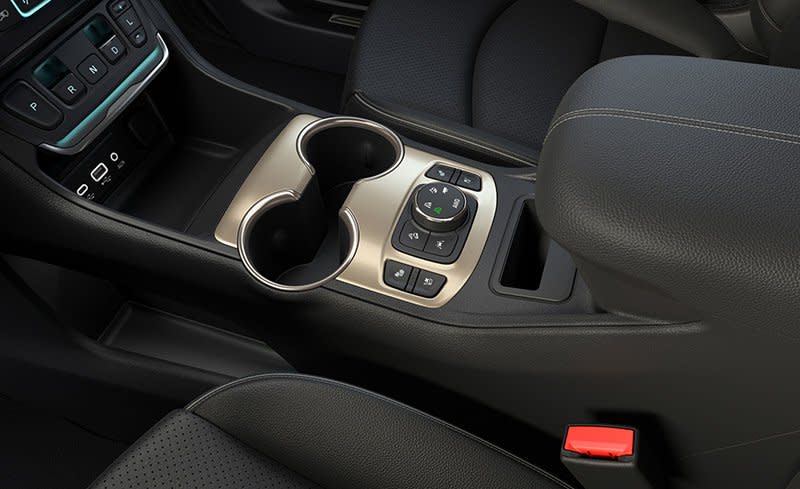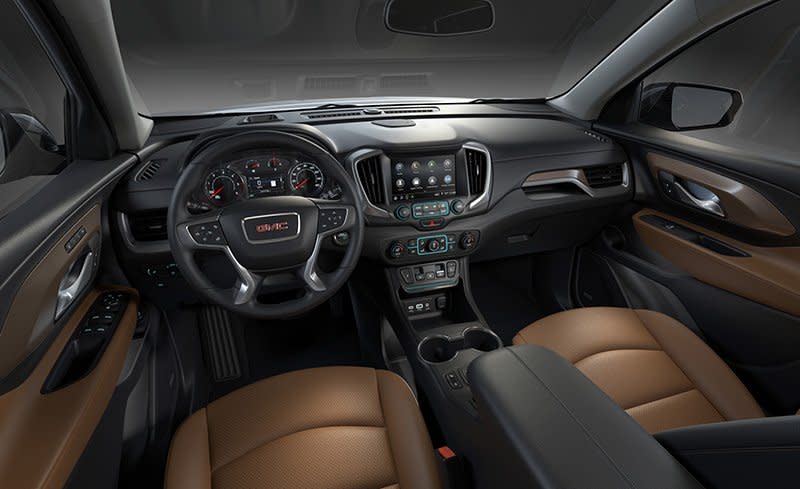2018 GMC Terrain

The GMC Terrain is a bit player in the epic cast that comprises the compact-crossover segment. A perennial sales understudy, the GMC had a U.S. sales volume of 87,925 units in 2016, a drop in the bucket compared with top-billed stars such as the Honda CR-V and the Ford Escape, which sold 357,335 and 307,069 tickets in the same year. GMC understands this and is confident that its individuality appeals to buyers who aren’t easily swayed by the public opinion of the moment.
Still, constant reinvention is the key to putting return customers in the seats, and the 2018 GMC Terrain is new from the foundation on up. Undoubtedly, the Terrain’s indie strategy would not be possible without the economy of scale provided by the Chevrolet Equinox, its bigger-selling mechanical sibling. For its part, the Terrain focuses on premium features, styling, and specific chassis tuning.

Family Benefactor
We’re on the record with favorable impressions of the new 2018 Equinox, and that regard carries through to the Terrain. Five minutes into our drive of a full-boat, 2.0-liter Denali AWD, lingering memories of the first-gen Terrain vanished like Adrian Zmed’s career. Seating and interior materials are on par with other GMC products, functional first but a bit more premium than Chevy stuff—if your definition of “premium” is slightly thicker and more durable. Some of the Terrain’s approximately 350 pounds of weight savings over its predecessor were achieved in the seat frames, but you wouldn’t know it by sitting in the comfortably firm front buckets. GMC says the multi-density padding helps this cause, although note that those looking for significant side bolsters will be disappointed.
Even though the new Terrain’s wheelbase spans 5.2 inches less than before and it’s 3.2 inches shorter overall, rear passengers get a tiny 0.2 inch gain in legroom. We couldn’t really detect that, but we can confirm that two adults can survive long trips in the benchlike rear seats without the aid of muscle relaxers. It’s the cargo room that took a hit from the resizing, with space behind the second-row seat shrinking to 30 cubic feet from the previous model’s 32. Offsetting that somewhat is that the flat-folding front passenger seat now allows carrying materials up to eight-feet long (think dimensional lumber, not sheets), adding versatility the previous model lacked.
The 252-hp turbocharged 2.0-liter inline-four and nine-speed automatic transaxle come standard with the Denali package, and rightly so. Quiet at idle, the engine transmits virtually no harsh vibration through the chassis. Before we set off in the urban environs of Pittsburgh, however, we had to deal with the Terrain’s controversial electronic shifter mounted low on the center stack. Composed of five buttons (P, R, N, D, and L, the last also serving as a manual gear selector of sorts), it’s easier to use than it sounds. GMC’s spin on the topic is that it’s just another step in the march toward autonomy, but meanwhile, it’s a distinctive if slightly inelegant way to free up console space while ensuring that operators pay attention when selecting the proper function. We were effortlessly performing three-point parking procedures by the end of the first day.

Once out into the hills that surround Steel Town, the 2.0-liter and nine-speed auto performed competently if not remarkably. No tentative shift action, no unrequested games of Pick-a-Gear, just quiet motivation. The tranquil mood is aided by the quiet cabin, thanks to a new woven sound-deadening material that is both lighter and more effective than the asphalt-based materials used previously. Highway stretches were infuriatingly boring, and we mean that in the best way possible. Out here, you’re just another pod traveling along at 75 mph, so you may as well be comfortable.
On the broken, winding, and looping back roads near Frank Lloyd Wright’s Falling Water home is where the Terrain revealed its best-kept secret: It’s not a total drag to drive enthusiastically. The linear electrically assisted power steering comes by way of a rack-mounted motor, sending orders to Hankook Ventus S1 Noble 2 tires on 19-inch aluminum wheels. GMC claims the chassis is stiffer and that it resists flex with aid from solidly mounted front and rear subframes. That means metal-to-metal mounting, leaving isolation chores to the suspension components and their own mounts.
The brake pedal is firm, General Motors engineers telling us they focused on calibrating for brake-pedal force rather than travel to regulate clamping effort. The first bit of pedal travel (13 percent, say the engineers) moves a massive amount of fluid to position the pads right up on the rotors, and from there mechanical leverage kicks in for more aggressive situations. What it means for the driver is light footwork and predictable results in situations where you want to scrub off just a touch of speed before a corner.

Referring to the aforementioned L “gear selector” as such is bit of a misnomer. In fact, it works more as a range selector of sorts, locking out the gears you want to avoid when towing or descending extreme grades, like downshifting an old-fashioned automatic transmission. Operation is simple: Push the L button and use the adjacent +/- keys to select the highest gear you want the transmission to engage. Select 5 or 6 and it will ride your choice downhill, employing engine compression to near the rev limit—no redline is marked on the tachometer—maintaining your rate of speed. Should you need a quick burst of acceleration, it will access gears 1 through 4 as normal. We employed it while following heavy industrial trucks down some pretty intense grades—just remember to tug the D switch to return to full automatic operation. It works all the way down to first gear, although we can’t imagine a situation short of idling through a crowded cow pasture where that choice would be desirable.
Also of note is the standard driver-controllable all-wheel-drive system that offers a front-drive mode that disconnects the rear axle to minimize drag and optimize fuel economy. As with most current systems, the AWD mode automatically controls the fore/aft torque distribution and adjusts throttle response based on numerous inputs. We cycled through both of these and the trailer-towing mode, and we didn’t hear any weird clunks or experience odd dynamics under acceleration during our brief exposure.
Two More Turbos
It’s easy to focus on the performance of the 2.0-liter, but GMC expects 60 percent of buyers to opt for the standard 170-hp turbocharged 1.5-liter inline-four and just 10 percent to choose the 1.6-liter turbo-diesel, which makes 137 horsepower. We snagged a Terrain SLE with the 1.5-liter for a quick jaunt and found some not-so-shocking results: It feels very similar to the 2.0, but slower. The ride is a little less refined, as the SLE lacks the Denali’s specific chassis tuning. Also, the audio system’s six speakers lacked the Bose logos and sound quality of the Denali’s seven-speaker unit, the stance on painted 17-inch wheels wasn’t as purposeful as the Denali’s on its 19-inchers, and the climate control was manual. None of this significantly degraded the driving experience. The 1.5 shares the nine-speed auto with the 2.0 (not the case with the Equinox, where the 1.5-liter models get the old six-speed), but the lack of hustle was pronounced. We’ll find out how much slower the 1.5 is when we get the opportunity to strap test instruments to each version.

As for the diesel, no one outside of a small segment of torque-obsessed pickup owners buys into compression ignition expecting to burn rubber. Most are drawn by fuel economy. In the Terrain diesel’s case, the official EPA highway estimate is 39 mpg (FWD; it’s 38 mpg with AWD). That’s a full 13 mpg better than the FWD 2.0-liter and 9 better than the FWD 1.5-liter. At current fuel prices, the $3800 upcharge (which is an approximation, since it’s bundled with additional features) would require more than 150,000 miles to break even, assuming both models achieved their advertised highway economy over that distance. It’s most diesel-like at idle, although even then the clatter is somewhat subdued. Acceleration is steady but not helped by being teamed with the old six-speed automatic. If you’re a diesel lover, it’s likely you know what you are looking for long before you hit the showroom. We were disappointed to learn that this diesel—like the 1.5-liter gas engine—is limited to tow just 1500 pounds. The 2.0-liter is rated to tug up to 3500 pounds. GMC mixes up the available features, powertrains, and four trims (SL, SLE, SLT, and Denali) extensively; additional pricing specifics can be found here.
The 2018 Terrain finds itself in the enviable niche of being able to focus on pleasing dedicated fans without bearing the entire brunt of the development cost. Sometimes it pays to be a supporting member of the cast.
Specifications >
VEHICLE TYPE: front-engine, front- or front-/all-wheel-drive, 5-passenger, 4-door hatchback
ESTIMATED BASE PRICES: SL, $25,970;
SLE, $28,795;
SLT, $32,295;
Denali, $38,495
ENGINE TYPES: turbocharged and intercooled DOHC 16-valve diesel 1.6-liter inline-4, 137 hp, 240 lb-ft;
turbocharged and intercooled DOHC 16-valve 1.5-liter inline-4, 170 hp, 203 lb-ft;
turbocharged and intercooled DOHC 16-valve 1.5-liter inline-4, 252 hp, 260 lb-ft
TRANSMISSIONS: 6-speed automatic with manual shifting mode, 9-speed automatic with manual shifting mode
DIMENSIONS:
Wheelbase: 107.3 in
Length: 182.3 in
Width: 72.4 in Height: 65.4 in
Passenger volume: 103 cu ft
Cargo volume: 30 cu ft
Curb weight (C/D est): 3500–3850 lb
PERFORMANCE (C/D EST):
Zero to 60 mph: 6.4–10.6 sec
Zero to 100 mph: 16.5–28.0 sec
Standing ¼-mile: 15.0–17.3 sec
Top speed: 115–130 mph
FUEL ECONOMY:
EPA combined/city/highway: 23–32/21–28/26–39 mpg

 Yahoo News
Yahoo News 
